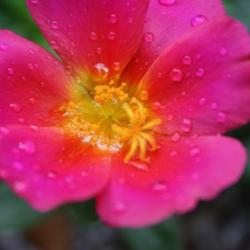
Shoulders slumped, I surveyed my sweet corn patch. Once again wind, drought, borers and raccoons had wiped out my harvest. Between the toppled stalks, however, purslane sprawled green and succulent over the cracked clay. I couldn't imagine relishing purslane more than sweet corn, but I decided to take a closer look at this easily grown edible weed.
On paper, purslane (Portulaca oleracea) sounded great! I learned that researchers have identified it as the richest source of omega-3 fatty acids, which lower lipid levels in the blood, of any vegetable yet examined. A single serving of fresh purslane leaves (a little less than a cup) provides the minimum daily requirement of alpha-linolenic acid, a type of omega-3 fatty acid. The usual source for a concentrated dose of omega-3 is fish oil -- I figured purslane had to be more palatable than that!
It's also high in vitamin E, according to Dr. James Duke, a USDA botanist in Beltsville, Maryland, and an expert on the nutritional value of wild and semi-wild plants. A modest portion of purslane provides far more vitamin E than any other vegetable -- six times more than an equal amount of spinach, for example -- plus significant doses of vitamins A and C.
That convinced me of purslane's worth, but I probably wouldn't have taken my research anywhere near this far if I hadn't also come upon a non-weedy type of purslane in some seed catalogs. Long sold in produce markets throughout the Netherlands, France, Italy, Greece and Turkey, this cultivated variety is also used in salads under the name verdelagas at restaurants in the American Southwest.
There's little difference between wild and cultivated purslane in nutrient content or taste. Unlike the dirt-doused weedy purslane that invades my corn patch, however, domesticated varieties of P. oleracea grow upright and stay quite clean. They have dark green oval leaves as big as silver dollars, similar to jade plants in leaf shape and thickness. There is even a variety with golden green leaves called 'Goldgelber' or 'Goldberg'.
Into the GardenPurslane is sensitive to frost, so I waited until May 1, when chickweed bloomed and apple leaves unfurled, to sow the tiny black seeds of a green-leaved cultivar in my zone 5 garden. I lightly covered seeds a half-inch apart in rows six inches apart.
Wild purslane sprouts quickly after a rain or near a hose leak. "The biggest challenge in the garden is to keep purslane seeds moist until germination, which takes four or five days," says Wendy Krupnick, formerly of Shepherd's Garden Seeds in Felton, California. Well, that isn't much of a challenge here in Michigan! My vegetable purslane seed sprouted fine with no extra coddling.
I thinned plants to four inches apart and in late June began cutting fleshy stems and leaves to within two inches of the base. Plants regrew for three more harvests. Shepherd Ogden, a former Vermont seedsman and a contributing editor to National Gardening magazine, makes multiple four-foot sowings and harvests each only once. "Purslane loses its pretty shape and the leaves get smaller with successive cuttings," he says. Multiple sowings assure a steady supply of high-quality purslane shoots all season long.
Into the KitchenI use purslane as a hot weather green in mixed salads. When July heat turns leaf lettuce limp and bitter, purslane leaves and stems offer mild lemony tang and a crunch. Used raw, purslane combines well with other ingredients of midsummer salads like cucumbers, zucchini, tomatoes, peppers, onions and lightly steamed beans or carrots. Dr. Artemis Simopoulos, a leading advocate of the nutritional benefits of purslane, compares fresh purslane to watercress and enjoys it in cucumber salads.
Dr. Simopoulos also told me that she boils purslane like spinach and cooks it in omelets. Cooked purslane, though, is a bit mucilaginous. And as purslane approaches the flowering stage, the stems become very like okra. This thickening quality is welcomed in lamb-lentil-purslane soup, a signature dish in southeastern Turkey. This summer I plan to stir-fry purslane with other vegetables and chicken.
Cultivated purslane drops seed but doesn't aggressively reseed; seeds-people from California to Connecticut confirm this tidy habit. By early August my trouble-free plants started to fade, yellow and dry out. They composted themselves by the first fall frost.
It is important to distinguish between these new cultivated forms of purslane and weedy kinds. Wild purslane is a noxious weed that thrives in all 50 states. Some weed scientists rank it as the most frequently reported weed species in the world and the ninth most detrimental weed to world agriculture. But everyone agrees that purslane is uncommonly nutritious. Seed companies have the best culinary varieties, so now it's up to gardeners to grow it and use it.
 Victory Seed Company has all the seeds you want for your best garden in 2024.
Victory Seed Company has all the seeds you want for your best garden in 2024.
For 25 years, the family-owned Victory Seed Company has provided the highest quality vegetable, herb and flower seeds to families across the country. We are passionate about providing you the best seeds available that give excellent germination, robust plants, and the harvest you want. With a catalog of over a thousand varieties, we have everything, and our prices are the kinds that we'd want to pay. We have hundreds of yesterday's heirloom vegetables, as well as today's award winning hybrid selections. Get to know us by visiting our website and browsing through our online vegetable seed catalog.